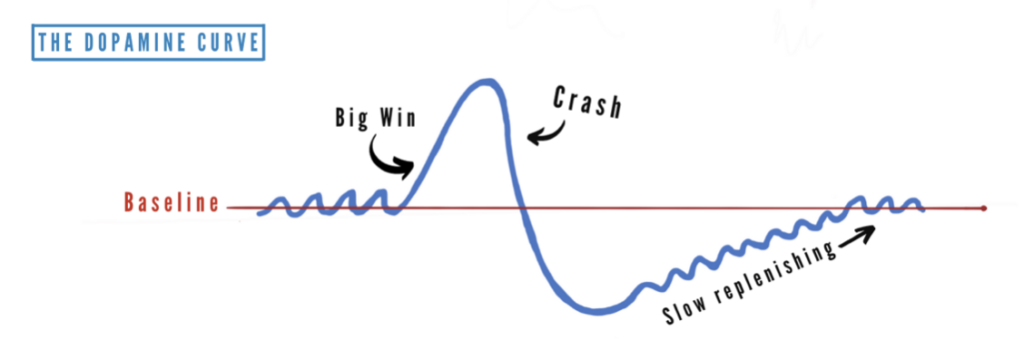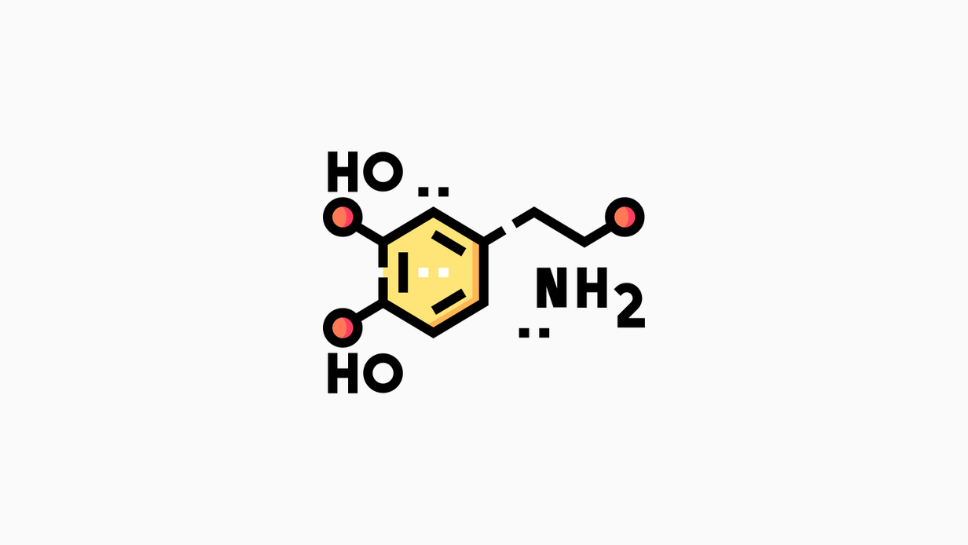Table of Contents
I used to be addicted.
Addicted to checking my phone, watching tv, and mentally escaping from all the stuff I had to do.
Just the thought of working was enough to make me yawn.
And a couple of minutes into tackling my first item on my to do list my mind was wandering, I was reaching for my phone, and looking for an easy way out.
I was looking for literally any excuse to avoid hard work.
But, things are different now.
I have zero issue with sitting down for extended periods of time doing work that, to many people, looks boring. Things like writing long articles, reading dense chunks of text, and checking off admin tasks that are so easy to just put off or completely ignore.
And the key to all this was understanding my unhealthy relationship with dopamine.
🧪 The Dopamine Problem
Dopamine play a crucial role in shaping our behaviour, motivating us to take action, and altering our levels of pleasure and reward in response to various stimuli.
But, our increasing dependence on technology, social media, and instant gratification is contributing to dysregulation of dopamine release, leading to a huge rise in addictive behaviours that negatively impact our mental health, physical health, and social relationships.
For example, it’s just so easy to get caught up in the endless scrolling of TikTok or Twitter or any other platform that’s designed to capture and hold our attention. The problem is that the instant gratification we experience from all the likes, comments and notifications sucks us into a cycle of seeking more and more engagement, eventually leading to addictive behaviours that lead many of us to feel depressed and dissatisfied with life.
❌ What we get wrong about dopamine
We’ve no doubt all experienced these feelings before.
But, what a lot of people don’t realise is that dopamine actually plays a super important role in our lives.
The Baseline of Dopamine
Our bodies are constantly producing dopamine at a steady rate to maintain a baseline level of activity in a process known as tonic release. For example, dopamine is what drives us to do every day tasks like getting out of bed or brushing our teeth. And it’s also responsible for regulating our mood and behaviour. Without dopamine in our system, then, we’d quite literally do nothing.
This baseline of dopamine is also different from person-to-person, meaning some people are going to be more motivated and driven compared to others. So, the higher the baseline the more motivated we’ll feel.
Spikes in Dopamine
The problem then is that the more times we do stuff that causes a spike in our natural dopamine level, through a process known as phasic release, we’re actually disrupting this baseline, screwing up our mood, behaviour and motivation.

So, when we do things we enjoy, we get a dopamine boost, but if we keep doing the same enjoyable thing over and over again, we may start to feel less and less pleasure from that activity. Eventually, when we stop doing the activity altogether, we often feel a big drop in dopamine levels, which is what leads to those feelings of sadness, disinterest, and low mood.
So, if we want to manage our mood, behaviour and motivation we need to understand two things:
- One, how to prevent spikes in our dopamine levels that disrupt the natural dopamine baseline
- And, two, how we can increase our baseline levels of dopamine in a sustainable way, such that we become naturally more happy, driven and engaged with the world around us.
💥 What Causes Dopamine to Spike: ASCEND activities
To start, let’s address the initial question of how to prevent surges in our dopamine levels.
Now, the key is to understand which activities trigger dopamine spikes, allowing us to effectively regulate them. And I refer to these activities as ASCEND activities, which stands for Artificial rewards, Sex, Chocolate, Exercise, Nicotine, and Drugs.
Sure, there are many other activities that influence our levels of dopamine, but this list covers the broad spectrum of stuff that gives us the biggest dopamine spikes above our baseline levels.
Chocolate & Sex
For example, a 2013 study found that consuming chocolate increases levels of dopamine by about 1.5 times above our baseline and another study found that sex increases our baseline levels of dopamine by about 2 times, although this depends on individual factor such as age, gender, and sexual orientation. But, it’s important to note that the effect of sex and chocolate on our dopamine levels is transient, which means it doesn’t last long. This is why we’re never quite satisfied with having just one piece of chocolate.
Nicotine & Drugs
Nicotine and drugs have a slightly greater impact on our dopamine levels. Research has shown that smoking cigarettes can increase dopamine levels by around 2.5 times above our baseline. Whereas some drugs, like cocaine and amphetamines, are known to increase dopamine levels in the brain significantly more than this. Methamphetamine, for example, has been found to increase dopamine levels in the brain by a ridiculous 10 times above our baseline, causing a huge amount of disruption to our naturally occurring levels of dopamine.
Exercise
You may be surprised that exercise is included in this list, but the point is that it’s not just classically unhealthy habits that spike our dopamine. Research suggests that exercise can increase dopamine levels in the brain by up to 2.5 times above baseline, similar to the increase in dopamine levels seen with having sex.
In a similar way, we experience spikes in dopamine when we achieve a goal and accomplish something difficult or when we have some sort of positive social interaction with a friend or colleague.
So, the point is that we need to be careful not to cause too many spikes in our dopamine levels, regardless of whether those spikes come from doing something ‘bad’ or ‘good’. Which leads us on to the second question: how do we do this and ensure we maintain a healthy baseline of dopamine in our body?
💆 Dopamine Detox: How to Manage Dopamine
So, there are 4 things that I’ve found to be particularly helpful:
- Avoid dopamine layering
- Use intermittent reward schedule
- Build routine
- Understand subjectivity
1Dopamine Layering
Dopamine layering is where we combine multiple sources of dopamine at the same time.
For example, many of us when going to the gym will listen to music, drink some pre-workout, go at our favourite time of day, text people, and do everything we can to make it a more enjoyable experience.
But, the problem with this is that by layering all these things to get this huge peak in dopamine we’re 1) increasing the number of conditions required to achieve pleasure from that activity again, and 2) going to have a huge crash in our dopamine shortly afterwards, which ultimately undermines our longer-term motivation and drive.
So, what we should be doing is removing multiple sources of dopamine release from activities that we want to continue to enjoy. For instance, try to do some workouts without music, without your phone or without caffeine. This can help foster more sustainable intrinsic motivation and lessen the likelihood of dopamine crashes.
2Intermittent Reward Schedule
While it’s super important for us to continue doing stuff we enjoy (seeing friends, having sex, taking drugs… maybe not taking drugs actually), the key is to not expect or chase high levels of dopamine release every time we engage in these activities.
Instead, we want to change the amount of dopamine we get from an activity at random (that’s what we mean by an intermittent reward schedule). This keeps us engaged with an activity for longer, makes us want to return to that activity at a later date, and prevents huge spikes + crashes in dopamine.
For example, intermittent reward schedules is exactly how casinos keep us gambling. We don’t know when we’re going to win and when we’re going to lose. It’s also how potential partners keep us texting + pursuing them. We don’t know whether that person is attracted to us or not. And it’s also the mechanism that keeps us addicted to social media.
So, in practice, we need to find ways to avoid predictable schedules for dopamine release.
My advice is to start paying attention to the amount of dopamine or pleasure you get from activities, and start modulating that at random. One way you could do this is to flip a coin before engaging in any of these activities and decide whether or not you’re going to allow other dopamine supportive elements e.g. if you enjoy listening to music when you go to the gym, flip a coin and if it lands on ‘heads’ then listen to the music, but if it lands on ‘tails’ then don’t.
Another thing to do is to not celebrate every win. Sometimes when you reach a milestone, instead of enjoying that moment, just keep going. And learn to associate ‘winning’ with the effort itself.
In fact, you can learn to evoke dopamine release from the friction and the challenge you happen to be in, which is a far healthier form of dopamine release compared to that you get from purely pleasurable activities.
3Morning Routine
Getting some early morning sunlight for 10-30 minutes daily causes the release of dopamine. And if done consistently, it will also increase levels of gene expression for certain dopamine receptors.
In other words, sunlight helps us to use dopamine more effectively, which makes our mood better, increases our motivation, and helps us to think a little sharper.
If you’re up to it, you can also try taking a 1-3 minute cold shower – as cold as you can safely tolerate – which is something I started doing myself relatively recently.
There’s a really fascinating study on this – which I’ll drop below the video – where people were submerged in cold water for around 10-15 minutes, causing dopamine to be released in their body 250% above their baseline. And this dopamine increase was sustained for many hours after they got out of the water.
Basically, this meant there wasn’t this huge crash in dopamine following the spike. Instead, the baseline level of dopamine increased and stayed at that level for an extended period of time, helping them to feel happy and motivated for longer.
4Subjectivity
It’s important to understand that the brain doesn’t directly know about external rewards like money or gifts. Instead, it recognises patterns and associations between events and the release of certain chemicals, such as dopamine, within the brain.
So, the dopamine system and the feeling of being on the right track are more within your control than you might think.
The part of the brain called the prefrontal cortex, which is responsible for decision-making and planning, is connected to the dopamine pathway, meaning it has the ability to influence your motivation levels based on your beliefs and perceptions.
So, when we tell ourself that we’re making progress towards our goals, it can have a significant impact on the release of dopamine in our brain. This is not a placebo effect or a small change. It’s a real and powerful connection between our thoughts and the chemicals in our brain.
Of course, it’s important to be honest with ourself. We can’t trick our brain by pretending we’ve achieved something when we haven’t.
But as we make progress, we should acknowledge and register those achievements in our mind. It can be a strong stimulator of dopamine release and keep us motivated on our journey.

